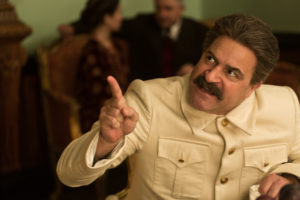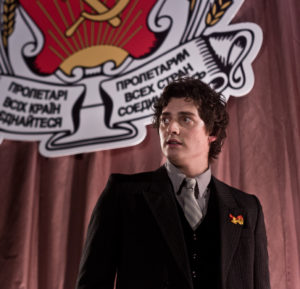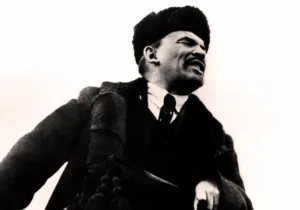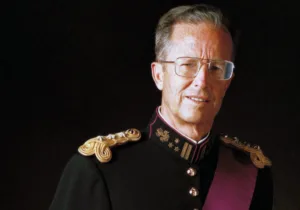Allow me to preface my Bitter Harvest critical review. The fact a mainstream film focused on the Holodomor came to the silver screen is no small accomplishment. Millions of Ukrainian heritage, myself included, are deeply grateful to Ian Ihnatowycz, who fully financed Bitter Harvest’s $20 million budget, despite knowing it may not profit at the box office. Ihnatowycz’s generosity produced a heartfelt full-length film dedicated to the Holodomor’s innocent victims and sheds light on both Russia’s history of aggression against Ukraine and communism’s greater legacy of death. I would like to express my heartfelt thanks to everyone involved in the film’s production.
Bitter Harvest is a touching film about a tragic and important piece of history. I have praised the films strongest points and hope that Director George Mendeluk’s work will inspire other directors to make an even better movie about the Holodmor. That being said, Bitter Harvest is undoubtedly not without several discernible weaknesses that detract from its overall quality.

Production wise, the film is genuinely mediocre. Most characters are shallow and plainly one-dimensional. While Yuri and Natalka seem to have credible chemistry, their love story is relatively generic and awash in predictable Hollywood clichés. The writing is ostensibly weak and generally fails to pull serious emotional punches. There is no excuse for this as Mendeluk could have finessed more emotionally impactful storytelling from the plentiful historical material.
Bitter Harvest does not convey fully enough the gut-wrenching horrors the Holodomor’s victims experienced. There are no mentions of cannibalism; no depictions of Soviet soldiers erecting watchtowers over fields to ensure workers harvesting wheat would not “steal” food for private consumption; no representation of how entire villages perished and how the Kremlin strategically relocated Russians into emptied Ukrainian homes whose residents died to repopulate Ukraine with Russians (a contributing factor to why today eastern Ukraine has a sizable ethnic Russian population); no portrayal of how the fatal combination of scarce resources and extreme hunger turned communities against each other by creating bandit gangs that roamed the country pillaging for food; or how the Holodomor effectively destroyed Ukraine’s bedrock of Christian morality since Ukraine’s most morally upstanding individuals (the clergy, Christian sect communities, and those who refused to engage in cannibalism, crime, or prostitution) perished first.

Some historical inaccuracies also plague Bitter Harvest. For example, the film depicts Soviet soldiers in grain requisition squads as being exclusively ethnic Russians, which is historically inaccurate. While Stalin’s genocidal policies came from Moscow, they could not have been fully implemented without Ukrainian communist collaborators and complicit Soviet Ukrainian authorities. More nuance about some Ukrainians’ collaboration with Stalin could have given the film some much-needed depth. Bitter Harvest also inaccurately displays Yuri’s village in the distinct style of western Ukrainian culture, despite that during the Holodomor western Ukraine was part of Poland and unscathed from catastrophic man-made famine.

Bitter Harvest also ineffectively stiches together too many themes, and its purpose is sometimes unclear. Ostensibly a love story, the film still emphasizes action sequences (Cossack horse fighting, gun battles, and chase scenes). It could be easily misunderstood as a Ukrainian independence political drama or an action film with a love story thrown in. Viewers could mistakenly believe the majority of the Holodomor’s victims were combatants who died in armed uprisings. In reality, the overwhelming majority of victims were ordinary civilians who perished agonizingly slowly and helplessly from hunger. Focusing on several aspects of the Holodomor at only a surface level, Bitter Harvest spreads itself thin on a very complex historical event.
The most painfully obvious example of this is found in Mendeluk’s decision to include Mykola Skrypnyk, the controversial Ukrainian Bolshevik statesman. Skrypnyk rose through the ranks of Soviet Ukrainian government during the USSR’s early years and eventually became the Head of the Ukrainian SSR’s State Planning Committee. Despite being a Chekist who opposed Ukrainian resistance to communism, throughout his career Skrypnyk defended Ukraine from Moscow. He promoted Ukrainianization, Ukrainian language and culture, and protected Ukraine’s territorial integrity by successfully opposing the Kremlin’s desire to divide Ukraine with the Donetsk–Krivoy Rog Soviet Republic in Ukraine’s east (a tactic revisited and implemented by the Kremlin nearly a century later in contemporary Donetsk and Luhansk). During the height of the Holodomor in summer of 1933 when an estimated 28,000 Ukrainians were dying per day, Skrypnyk, knowing his countrymen’s suffering and Stalin’s plan to liquidate him, took his own life.

In Bitter Harvest Skrypnyk is the protagonist’s childhood friend, and his ascension through the communist ranks is briefly covered. In one poorly explained scene, Skrypnyk’s desire to simultaneously advance both Ukrainian independence and communism is shown. Unfortunately, Bitter Harvest doesn’t clearly explain to an audience unacquainted with finer details of Ukrainian history the full ramifications of Skrypnyk’s fatal dilemma. The audience is never given a proper introduction to the historical significance of his character, and his dramatic suicide scene, lacking proper historical context, leaves the audience confused. Skrypnyk’s character could have been an excellent opportunity to highlight the complexity of the Ukrainian independence movement in the face of Stalin’s imperialistic ambitions. Mendeluk could have also used Skrypnyk’s character, a man who learned the hard way that embracing Leninism and advancing Ukrainian independence are two inherently incompatible objectives, to give the film some sorely needed character development. Unfortunately, Mendeluk’s attempt to include elements of Skrypnyk’s complicated history into the Bitter Harvest’s plot appear shoehorned and disorganized.
These weaknesses notwithstanding, I still definitely recommend Bitter Harvest. To be fair to Mendeluk, covering a complex issue like the Holodomor in a non-documentary film is an extraordinarily difficult undertaking, and he does a very good job. I hope Bitter Harvest will increase Americans’ public awareness of both communism’s bloody legacy and Russia’s history of aggression against the people of Ukraine. The history which the film tells is important, relatively unknown, and aside from some technical historical details, portrayed reasonably accurately.
—
George Barros is a Washington-based analyst who concentrates on Ukraine and Russia. He previously worked as a foreign policy advisor for a former member of Congress who served on the Subcommittee on Europe, Eurasia, and Emerging Threats. You can find him on Twitter at @curiousgeorgie_
Feature Photo Credit: Detail of poster from the film Bitter Harvest.







 Sponsor a student for Christianity & National Security 2024
Sponsor a student for Christianity & National Security 2024